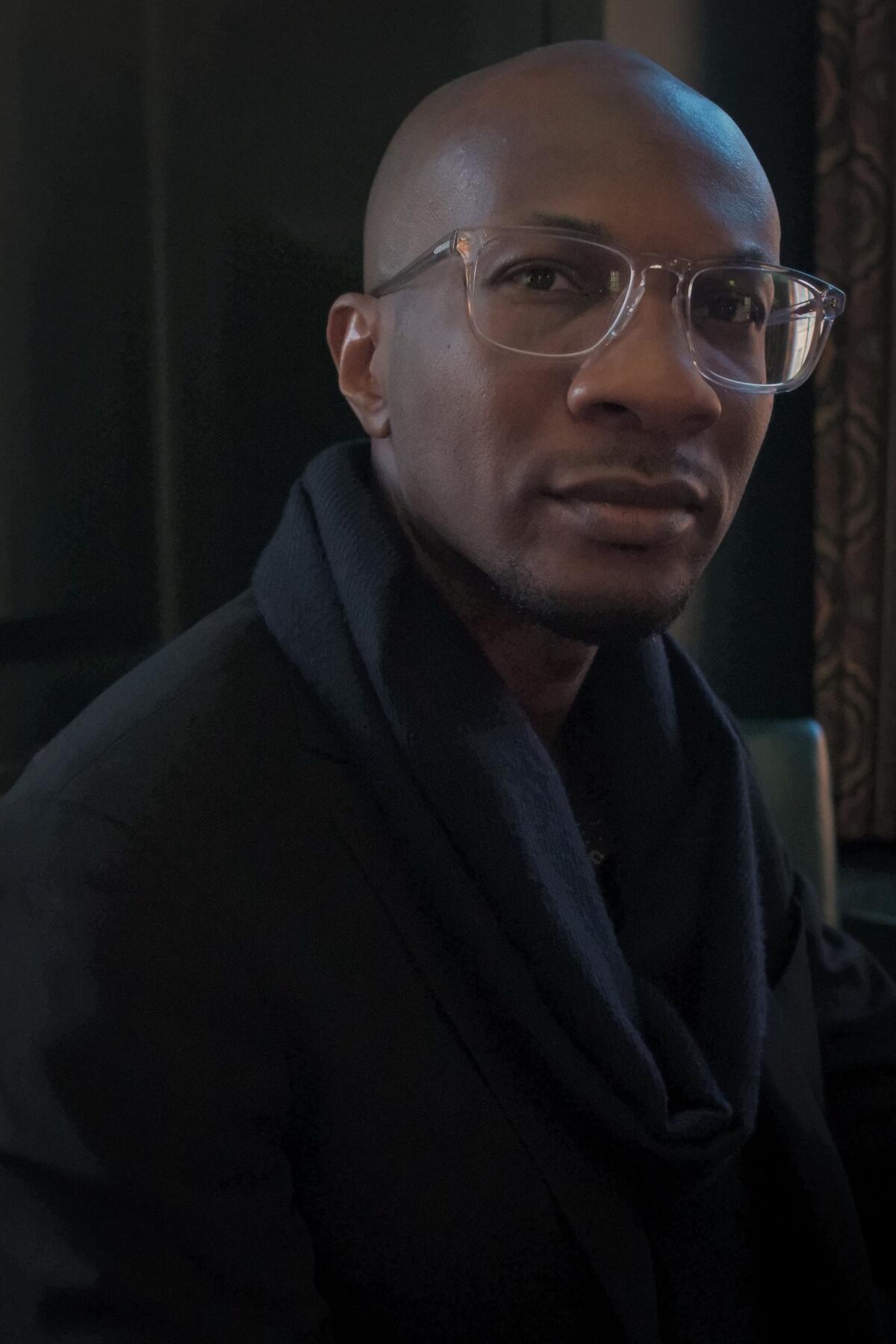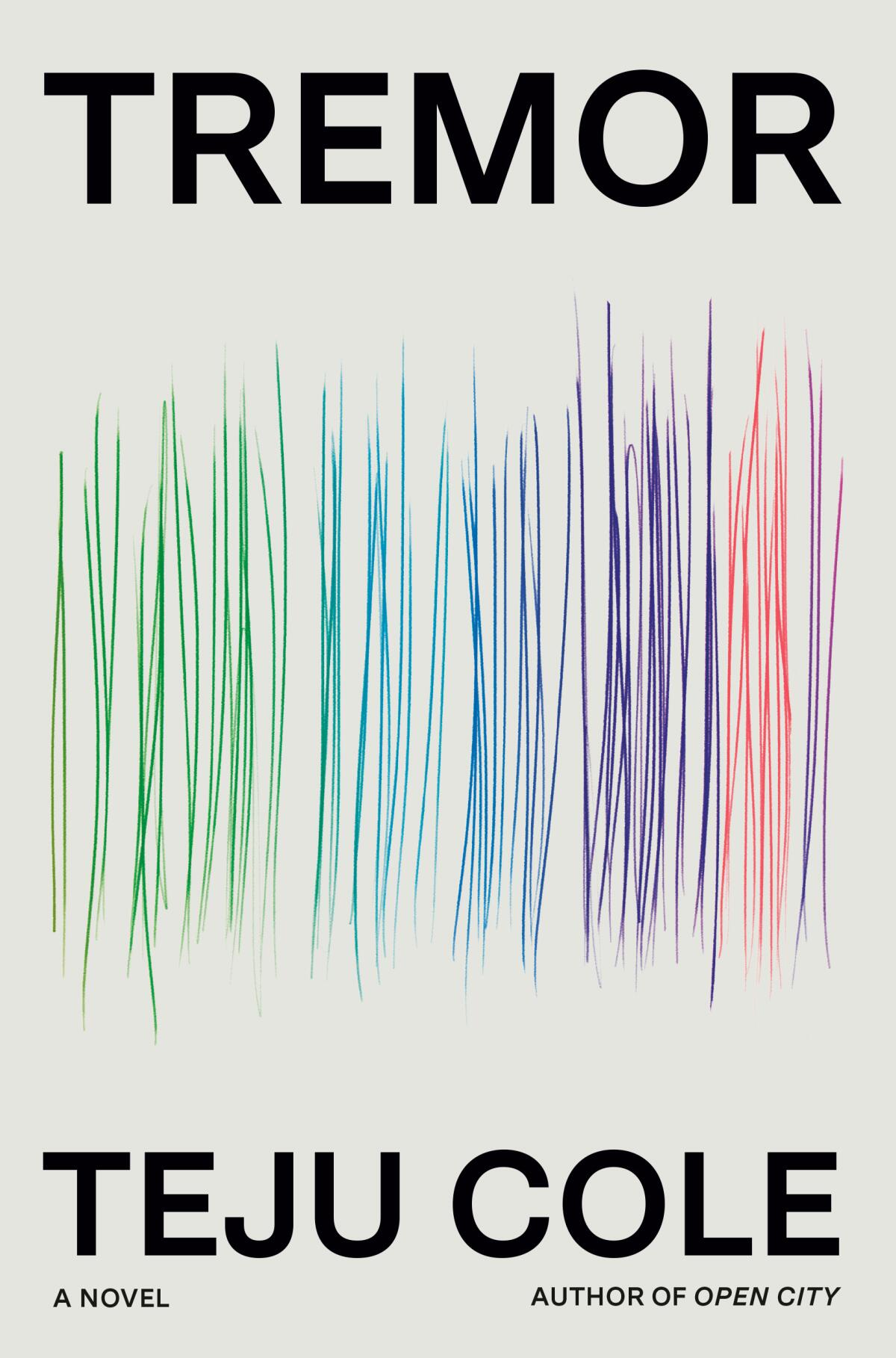How Teju Cole’s new novel literally reframes the Black experience

- Share via
Review
Tremor
By Teju Cole
Random House, 256 pages, $28
If you buy books linked on our site, The Times may earn a commission from Bookshop.org, whose fees support independent bookstores.
In his 2022 photo series, “Night Coming Tenderly, Black,” photographer Dawoud Bey reimagines the path of enslaved people escaping along the Underground Railroad. The photographs were taken during the daytime but printed in black and gray tones, giving them an eerie quality, illuminating what never could have been seen under the cover of darkness.
Similarly, Teju Cole’s latest novel, “Tremor,” asks what, exactly, are we looking at? Like Cole, the book’s narrator, Tunde, is a professor, photographer and art critic. Like Cole, he teaches at Harvard and was born in Nigeria. When the novel opens we find Tunde — much as we could imagine Bey — setting up a shot of a “glossy and dark” hedge when “an aggressive voice calls out from the house on the right.” He explains he is just an artist, taking a photo. “You can’t do that here, the voice says, this is private property.”
‘Every Day Is for the Thief’ by Teju Cole (‘Open City’) is a wonderful meditation on modern life in Nigeria.
Later Tunde and his partner, Sadako, are antiquing in a small town outside Cambridge. The shopkeepers are friendly enough, but “behind the counter is a card signed by Laura Bush,” and the structure bears a historical plaque that explains its provenance. Its owner, in his will, bequeaths to his beloved wife “all my household stuff of every sort and kind, [and] my negro man Jeff.” As Tunde and Sadako place their treasures in their car, the old homestead is visible. “Between the house and the barn stands the great old tree under which their SUV is parked. All time is now.”
In Tunde’s world, “history’s bitter spray” is ever-present. He cannot step into Harvard Yard without thinking about the four people enslaved by two of the college’s presidents. “We know the names of the four: Venus, Bilhah, Titus, and Juba, two women and two men.” He cannot open his mail without a frequent reminder that there are those who would remove him from his job. “It’s not the first time. The message accuses him of being a fraud and being in a position that should have gone to someone more deserving.”

During a talk for an art museum, Tunde tells an incredible tale about the theft by the Nazis of the painting “Landscape With a Burning City,” which even landed in the hands of Hermann Göring before the museum took ownership. Still unsure to whom the painting “belongs,” the curators place a plea for “interested parties” to come forward. Yet there are no plaques or requests in the museum on the provenance of art stolen from Benin, a country in West Africa. “What does it mean,” Tunde asks the crowd, “to care about art but not about the people who made that art?”
There were times when “Tremor” reminded me of Faye’s exploits in Rachel Cusk’s “Outline” trilogy. But Cole’s writing is more interior than Cusk’s, and it does more telling than showing, except in a fascinating chapter that amplifies the voices of the people of Lagos, Nigeria’s largest city. This abrupt shift in narration destabilizes the reader — like the tremor of an earthquake, or the sudden loss of vision in one eye that Tunde experiences from time to time. Cole exposes the stain of history and the constant presence of racism, fear and violence in Tunde’s daily life, raising questions about the role these things play in our art and, more specifically, in the novel. “Tremor” is a commentary on — or perhaps an answer to — the criticism that autofiction often focuses on upper-class white people.
L.A.’s 16 essential works of literary fiction, from ‘The Day of the Locust’ to ‘If He Hollers Let Him Go,’ ‘Play it as it Lays’ to ‘Interior Chinatown.’
This section of the book emboldens and expands Cole’s vision. Of Lagos, he writes: “It is a city in which people make love with the tremulous joy of first-timers, the solemnity of undertakers, the insouciance of professionals, the vigor of perverts, and the untiring ardor of immortals in whose every moment is a promise that there will be more where that came from tomorrow and the day after that.”
With this chapter, “Tremor” becomes more than the experience of Black Americans. It is the experience of Black people, of darkness, of being African, of being Nigerian, of being Black in a global sense.
“On returning to the city he found it grim and was tempted to call it a post-traumatic landscape except that would have suggested the trauma was in the past,” Tunde thinks of Lagos. “It is a city of unspoken sufferings.” Upon returning to Cambridge, where a friend is undergoing cancer treatment, Tunde reminds himself that “a lot of the suffering we will witness in life will be greater than ours. There’s the question of what we can do to help and the different question of what to do when we can’t help.”
In photography, often the subjects are past help. “There’s a good chance the person is dead and the reason they are being pictured at all is because they are dead,” Tunde thinks.
“All photographs are memento mori,” as Susan Sontag wrote in “On Photography.” “To photograph is to participate in another person’s (or thing’s) mortality, vulnerability, mutability. Precisely by slicing out this moment and freezing it, all photographs testify to time’s relentless melt.”
Teju Cole sits at the center of a peculiar Venn diagram: He is a novelist who does double duty as a photographer and a photographer who also happens to be a photography critic.
Moreover, Tunde argues, the human mind is always eager to know how a person died because the answer gives us a narrative. “In order to begin to absorb the pain of the loss we need a narrative,” Tunde believes. In other words: the big picture. Tunde finds himself watching a French TV series about a spy who hopes to save a Syrian woman he loves. “It is a story about one white man in Paris arranging for a personal reason to have thousands of Arabs whom he does not know killed.” The show is well-made: well-written, well-acted, and Tunde must pull himself away from it. A good story has power.
“Tremor” asks us to remember that context matters. Cole’s images of the people of Lagos reflect stories that are both small and large. In looking at them, the viewer must consider what is in and outside the frame. At first glance, the subjects of the photographs in “Night Coming Tenderly, Black” are benign landscapes. They are untitled, but No. 14, in parentheses, tells us it is the site of “John Brown’s Tannery.” Significance and meaning, in both life and art, come from context. As Cole writes, “All time is now.”
Ferri is the owner of Womb House Books and the author, most recently, of “Silent Cities San Francisco.”
More to Read
Sign up for our Book Club newsletter
Get the latest news, events and more from the Los Angeles Times Book Club, and help us get L.A. reading and talking.
You may occasionally receive promotional content from the Los Angeles Times.









